
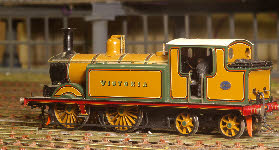


Updated January 2026
B2 no 320 ‘Rastrick’.
B4 no 64 ‘Norfolk’.
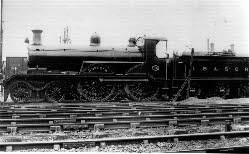 Robert Billinton designed his B2 4-
Robert Billinton designed his B2 4-4-0 engines to replace the aging Gladstones and G class singles, but it quickly became clear that these engines were too small and too lightly built to provide the power necessary to pull the increasingly heavy express trains. In 1899 the LBSC Board gave consent for the construction of 20 new engines, with wheels and chassis of the B2, but larger in every other respect.
Most were built by Sharp Stewart & Co, and were an immediate success. The class eventually totalled 33 engines.
No 64 was built in 1901, and withdrawn in 1935. It was originally named ‘Windsor’, but was renamed ‘Norfolk’ in 1908.
I think this is the most difficult loco I have made so far.
There were all sorts of little problems in the body work. Hand-fretting the running plate valence, and then bending the running plate to match was interesting, but making and fitting the splashers over the trailing driving wheels was more difficult. I had three or four goes at that before I finally achieved a result I as happy with.
The boiler fittings were all hand turned to a basic shape, and then finished off with a burr to match the shoulders to the boiler. The safety valves are an assembly of several separate parts, soldered together with lots of low-melt to fill the gaps, before hand finishing to shape.
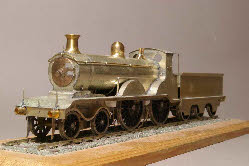 Most of the detail on the loco is complete in this photo, but still lots of work to be done on the tender.
Most of the detail on the loco is complete in this photo, but still lots of work to be done on the tender.
I have to say that I cheated a little, and bought the white metal fittings for the tender from London Road models. I couldn't face scratchbuilding six axleboxes and springs.
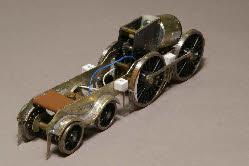 The photo (right) shows the basic layout of the chassis. It is very similar in design to D3 Victoria -
The photo (right) shows the basic layout of the chassis. It is very similar in design to D3 Victoria - side-beams for the driving axles, and a fully compensated bogie (providing the third suspension point) with a simple pivot to hold it in place.
There is side play on the leading driving axle, but none elsewhere.
Pick up uses split axles as usual, but just on the driving axles. The pick-up wires are soldered to the axle bearings on the driving wheels, but in this photo have not yet been soldered to the side frames.
B2 no 320 ‘Rastrick’.
B4 no 64 ‘Norfolk’.
 Robert Billinton designed his B2 4-
Robert Billinton designed his B2 4-Most were built by Sharp Stewart & Co, and were an immediate success. The class eventually totalled 33 engines.
No 64 was built in 1901, and withdrawn in 1935. It was originally named ‘Windsor’, but was renamed ‘Norfolk’ in 1908.
I think this is the most difficult loco I have made so far.
There were all sorts of little problems in the body work. Hand-
The boiler fittings were all hand turned to a basic shape, and then finished off with a burr to match the shoulders to the boiler. The safety valves are an assembly of several separate parts, soldered together with lots of low-
 Most of the detail on the loco is complete in this photo, but still lots of work to be done on the tender.
Most of the detail on the loco is complete in this photo, but still lots of work to be done on the tender.I have to say that I cheated a little, and bought the white metal fittings for the tender from London Road models. I couldn't face scratchbuilding six axleboxes and springs.
 The photo (right) shows the basic layout of the chassis. It is very similar in design to D3 Victoria -
The photo (right) shows the basic layout of the chassis. It is very similar in design to D3 Victoria -There is side play on the leading driving axle, but none elsewhere.
Pick up uses split axles as usual, but just on the driving axles. The pick-
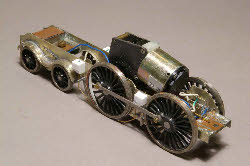 The back end. The motor is a Portescap 1616 with standard gearbox, but heavily cut down and sloping backwards to get it in the firebox.
The back end. The motor is a Portescap 1616 with standard gearbox, but heavily cut down and sloping backwards to get it in the firebox.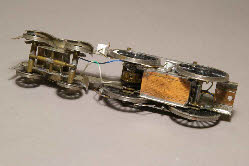 A view from the underside. The construction of the bogie can be clearly seen -
A view from the underside. The construction of the bogie can be clearly seen -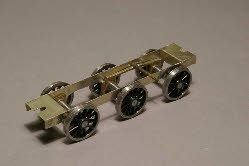 The very simple tender chassis, showing the very basic side-
The very simple tender chassis, showing the very basic side-I may need a bit of weight or a spring on the leading axle to keep it on the track.
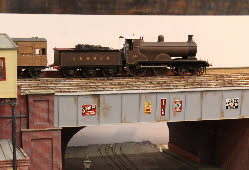 And finally, the (almost) finished loco, in Billinton Umber, on Brighton Road high level lines. At a late stage in the process, I decided to produce this B4 as ‘Norfolk’.
And finally, the (almost) finished loco, in Billinton Umber, on Brighton Road high level lines. At a late stage in the process, I decided to produce this B4 as ‘Norfolk’.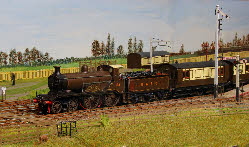 The photo (left) shows the finally finished engine with cab doors on the tender sides, and the name on the splasher, London bound from Plumpton Green.
The photo (left) shows the finally finished engine with cab doors on the tender sides, and the name on the splasher, London bound from Plumpton Green.